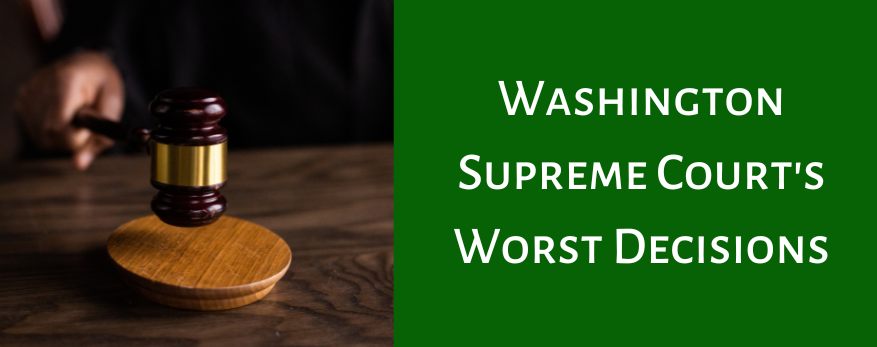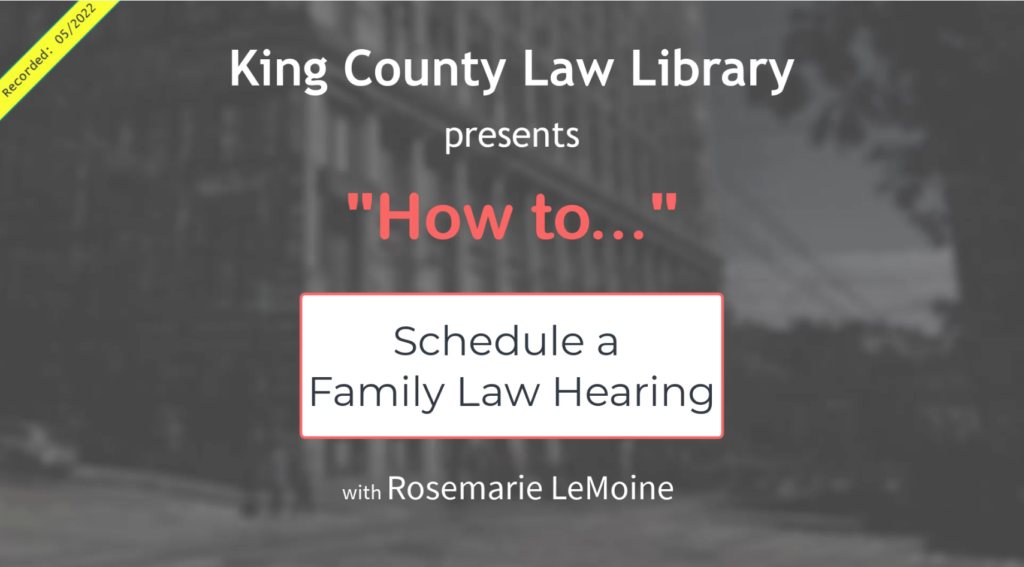
We get a lot of reference questions at the King County Law Library.
The refrain goes that because we aren’t practicing attorneys, we can’t offer legal advice—as librarians, we can only offer resources.
That said, some questions are very interesting & inspire me to do some research of my own, collected here in this column. Don’t construe this as legal advice!
****************************************************************************************************************************************
This is Ross’ Ref Q’s, a monthly column that looks at real law library reference questions with some kind of deeper payoff: Perhaps you’ll learn a novel research strategy or the answer to an unorthodox procedural question. This installment’s lesson can be largely distilled down to the dictum: don’t take anything for granted.
Someone came to the reference desk. They said that they wanted to evict someone and that [an agency] sent them our way, saying that we have a kit. We do have a kit. The short spiel on that goes: the bulk of “forms” for residential evictions aren’t necessarily state-provided, fill-in-the-blank forms, but are instead drafted one-off (usually by attorneys). Many small time landlords can’t afford attorney hourly rates, so KCLL worked with a local attorney to offer a kit that includes the typically necessary forms as well as instructions for the process. It can be bought in-library and on our website too.
There is a distinction in librarianship, and I suppose in customer service overall, where you want to follow the customer’s lead-to a degree. If someone comes in looking for a form packet for divorce, for example, I will clarify if they have kids or if the divorce is contested, as there are additional form sets in either case. But I won’t ask if they want to look at the Legal Separation packet, because while legal separation is similar to divorce and achieves many of the same outcomes, it is discrete enough that I have to assume they would request it specifically.
I will print the eviction kit on demand given the conversation flows as it usually does: Someone will come in and say they’re at wits end, a tenant has been causing trouble, they haven’t been paying rent, and they need them gone. That’s clear enough, that’s an eviction. Or they may even say, in a questioning voice, “I need an…unlawful detainer?” If that part is unclear I’ll ask if they want to evict someone or they are being evicted-of course, the methods vary greatly there. But I don’t ask if they’ve considered a protection order. It can have the same result, but I have to assume the person knows what they’re talking about, to a certain degree.
With COVID-19 changes to eviction law/procedure, we started prefacing eviction kit sales with some questions. “Are you aware of the moratoria?” Then, “Is the property located in Seattle or Burien?” These two had the longest lasting moratoria ie for the longest time, the kit wouldn’t work in these municipalities. But otherwise, I’ve assumed this person was a landlord and wanting to follow standard unlawful detainer actions under Washington Landlord-Tenant Law.
So, anyway… Someone came to the reference desk. They said that they wanted to evict someone and that [an agency] sent them our way, saying that we have a kit. We do have a kit.
With the moratoria finished, I ask the one qualifying question I have left: “Just to be sure, is the person you’re trying to evict on a lease?” They affirmed, I started swerving my cursor around to print the packet.
As I’m doing so, the patron continued railing against the renter, and casually lamented that it would have been great to have a roommate that actually helped with rent, but this person wasn’t paying. That’s a wrinkle.
I pull my cursor away from the “Print” button, and asked for clarification, “I might have misunderstood, are you the owner of the property?”
“No, I rent the place. I’m trying to evict my roommate.”
Ah. I’ve seen this before, and while I am not a lawyer, I feel comfortable saying, “Unfortunately landlord-tenant law, and eviction in general, is meant for … landlords and tenants. You can’t evict a roommate. There are resources out there, such as the Tenants’ Union and…”
So the conversation again diverged but again settled into an existing track. I have given this spiel before, and hope I didn’t speak mechanically. I asked if they have a relationship with their landlord, perhaps the landlord would want to evict him for not paying rent.
Then, interrupting, “But I am kinda his landlord. I’m subletting a room to him.”
Ah. This is a wrinkle I hadn’t seen before. At last, we’ve arrived at our titular ref q:
Can I evict a subtenant?
I brought up the Residential Landlord-Tenant Act on the Legislature’s website, clicked “Complete Chapter” and used Ctrl+F to look for “subl” which is broad enough to capture sublease and sublessor or sublessee, The Act includes “subl” five times, but makes only oblique references to sublessees and sublessors, mostly about drug-related prohibitions. These inclusions tell me that subtenancy seemingly isn’t regulated or prohibited in a unique way—there would probably be a section devoted to it, or at least some mention.
But in so searching, I see the word subtenant, so I search “subt” next. I see some more drug-related talk, the word “subtract,” but then…
RCW 59.18.410 — Forcible entry or detainer or unlawful detainer actions—Notice of default—Writ of restitution—Judgment—Execution.
RCW 59.18.650 — Eviction of tenant, refusal to continue tenancy, end of periodic tenancy—Cause—Notice—Penalties.
These are run-of-the-mill unlawful detainer statutes. “Subtenant” isn’t used in a majorly qualifying way, but in-line with other forms of tenancy.
If someone was asking our question in an academic way, I might give them the annotated code and let them continue research, but since our ref q has the embedded subquestion, “Can we use this eviction packet?” statutes weren’t an end point.
Instead, I grabbed the WSBA Real Property Deskbook. Knowing that some primary law existed in the RCWs gave me confidence that a secondary source like a deskbook would discuss subtenancy, and I wasn’t let down. §17.11(1)(a) discusses the differences between assignments and subleases—It’s a distinction worth noting because evidently a sublease without a reversion (the expectation that full possession of the property will revert to the original leaseholder for at least one day before the end of the balance term) is actually an assignment (which is the transfer of an entire balance of a lease). That subsection goes on to say “Between themselves, the head tenant and the subtenant stand in a true landlord-tenant relationship. The head tenant may bring an unlawful detainer action against its subtenant” and quotes relevant case law. Bingo. But, the subsection also offers this practice tip, “Many intended subleases are actually assignments or partial assignments because the head tenant fails to reserve a reversion. A party who makes an assignment instead of a sublease will not be able to recover possession through unlawful detainer.” Huh.
The patron made it out that they had a verbal sublease and not for the remaining balance, they were only supposed to be there until they got back on their feet. Is this periodic tenancy? Landlord-tenant RCWs swam before my eyes. I did my usual qualifiers (I’m not an attorney, you should probably talk to one, I can’t interpret the law or tell you what your rights are, but) and explained what I read. I said I can’t say for sure, but it appears you have a subtenancy, not an assignment, and it appears subtenant eviction falls under the purview of the Landlord-Tenant Act, which is what our packet is designed to do, and that while our packet costs $60 and could potentially fail for some reason, an attorney would certainly cost more. He ended up buying the packet.





